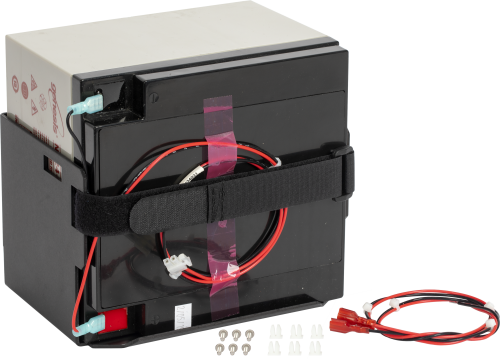
Overview
The BP2x is a rechargeable 12 Vdc, 24 or 26 Ah battery pack that can power a Campbell Scientific system. It is intended for high-current-drain systems, such as satellite transmitters, that require more power.
Read More
Images

Detailed Description
The BP2x requires a regulated charging source (provided by the CH150 or CH200 regulator connected to an unregulated solar panel or a wall charger). The BP2x includes a 24 in. attached cable that terminates in a connector for attaching the battery to a CH150 or CH200 regulator. The BP2x also comes with a 24 in. cable for use with the CR6 datalogger or other products that need a pigtail termination instead of a white connector. (This cable is bagged and taped to the battery.) Switching the standard cable for the pigtail cable is easily accomplished by the user. The BP2x is shipped with a bracket that secures the BP2x to an enclosure backplate. An ENC16/18 enclosure is recommended.
Specifications
| -NOTE- | Usable length of the red and black power leads extends at least 20 cm (8 in.) past the white cable tie tab. |
| Battery Type | Sealed lead acid (SLA) |
| UL Approval File Number | MH16464 |
| Output Voltage | 12 Vdc |
| Nominal Rating | 24 Ah |
| Battery Cables Length | 0.6 m (2 ft) |
| Dimensions |
|
| Weight | 10.2 kg (22.4 lb) |
Documents
Technical Papers
Videos & Tutorials
Frequently Asked Questions
Number of FAQs related to BP2x: 11
Expand AllCollapse All
-
No. The CH100 is designed to charge a 12 Vdc battery pack, not a 24 Vdc battery pack.
-
Not quite. The PS24 consists of a 24 Ah battery, a CH100 regulator, and a 10 by 12 in. environmental enclosure. Aside from the enclosure, the PS24 is very similar to a BP24 combined with a CH100.
-
Data loggers require stable power supplies to work properly, such as the BP24. If the system is needed for a long-term application, recharge the battery frequently, or recharge it daily with a solar panel of the appropriate size.
-
We do not offer a battery test kit. However, the CH200 charge regulator does have some features that could aid in discovering a bad battery, such as the ability to measure amperage into and out of the battery. Campbell Scientific recommends taking a voltmeter into the field to verify the battery voltage at different points to see if a dirty or corroded connection is causing a voltage drop in the system.
-
Check with the airline. Mention that the BP24 is a sealed, valve-regulated VRLA AGM battery.
-
Yes. Contact Campbell Scientific for a copy.
-
The BP24 should never be connected directly to an unregulated solar panel. A voltage regulator, such as the CH100, must be included in the circuit, or damage to the battery will occur.
-
Campbell Scientific recommends keeping the BP24 in an enclosure to protect the terminal from rain and condensation that could short out the battery.
-
The BP24 consists of a 24 Ah battery and a cable, along with a mounting bracket that can attach the battery to the diamond-punched backplates in Campbell Scientific enclosures.
The BP24 with a CH100 and a 10 in. by 12 in. enclosure with special mounting brackets is equivalent to a PS24.
The PS24 includes the BP24, a 10 in. by 12 in. enclosure, voltage regulator (CH100), back panel, mounting bracket and strap, and a longer power cable—all in one. The PS24 may be a suitable option when installing the battery in a separate enclosure because the data logger’s enclosure is not large enough to house the battery. The PS24 is often used with the ET107 when a larger battery is required.
-
Look for a stamp on top of the battery. The stamp may be in a date format of YYMMDDXX where:
- YY is the year.
- MM is the month.
- DD is the day.
- XX is the manufacturing plant.
This indicates the age of the battery.
Listed Under
Privacy Policy Update
We've updated our privacy policy. Learn More
